Films with theme "Documentary films about World War II", sorted by revenue
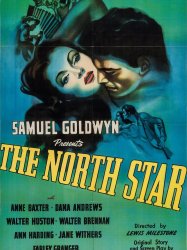
The North Star (1943)
, 1h48Directed by Lewis Milestone
Origin USA
Genres Drama, War, Action, Adventure
Themes Politique, Documentary films about war, Documentary films about historical events, Political films, Documentary films about World War II
Actors Anne Baxter, Dana Andrews, Walter Huston, Walter Brennan, Erich von Stroheim, Ann Harding
In June 1941 Ukrainian villagers are living in peace. As the school year ends, a group of friends decide to travel to Kiev for a holiday. To their horror, they find themselves attacked by German aircraft, part of the Nazi invasion of the Soviet Union. Eventually their village itself is occupied by the Nazis. Meanwhile, men and women take to the hills to form partisan militias.
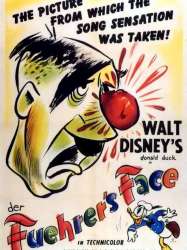
Der Fuehrer's Face (1943)
, 8minutesDirected by Jack Kinney
Origin USA
Genres Drama, War, Comedy, Musical, Animation
Themes Films about animals, Politique, Documentary films about war, Documentary films about historical events, Films about birds, Hitler, Political films, Documentary films about World War II, Mise en scène d'un canard, Children's films
Actors Billy Bletcher, Clarence Nash
Donald rêve qu'il est un citoyen de l'Allemagne nazie, et qu'il travaille dans une usine de munitions à Nutziland, s'épuisant à répondre aux demandes exagérées du Führer. Le dessin animé montre sa journée :

Mission to Moscow (1943)
, 2h4Directed by Michael Curtiz, Don Siegel
Origin USA
Genres Drama, War, Historical
Themes Politique, Documentary films about war, Documentary films about historical events, Political films, Documentary films about World War II
Actors Walter Huston, Ann Harding, Oskar Homolka, George Tobias, Gene Lockhart, Eleanor Parker
The film chronicles ambassador Davies' impressions of the Soviet Union, his meetings with Stalin, and his overall opinion of the Soviet Union and its ties with the United States. It is made in faux-documentary style, beginning with Davies meeting with president Franklin D. Roosevelt to discuss his new appointment as United States ambassador to the Soviet Union. It continues to show the Davies' family's trip by boat to Moscow, with stops in Europe.

Black Dragons (1942)
, 1h4Directed by William Nigh
Origin USA
Genres Science fiction, War, Thriller, Spy, Horror
Themes Spy films, Politique, Documentary films about war, Documentary films about historical events, Political films, Documentary films about World War II
Actors Bela Lugosi, Joan Barclay, Clayton Moore, Robert Frazer, Edward Peil Sr., Robert Fiske
It is prior to the commencement of World War II, and Japan's fiendish Black Dragon Society is hatching an evil plot with the Nazis. They instruct a brilliant scientist, Dr. Melcher, to travel to Japan on a secret mission. There he operates on six Japanese conspirators, transforming them to resemble six American leaders. The actual leaders are murdered and replaced with their likenesses. Dr. Melcher is condemned to a lifetime of imprisonment so the secret may die with him.

Blitz Wolf (1942)
, 9minutesDirected by Tex Avery
Origin USA
Genres War, Comedy, Animation
Themes Films about animals, Politique, Documentary films about war, Documentary films about historical events, Films about pigs, Wolves in film, Political films, Documentary films about World War II, Children's films, Mise en scène d'un mammifère
Actors Bill Thompson, Frank Graham, Pinto Colvig
Ce dessin animé est une parodie de l'histoire bien connue des Trois Petits Cochons, produit dans le ton de la propagande anti-nazis de la Seconde Guerre mondiale. Dans ce dessin animé, les cochons partent en guerre contre Adolf le Loup (sous les traits d’Adolf Hitler), qui menace d'envahir Cochonland (Pigmania dans la version américaine). Les deux cochons qui construisent leurs maisons en paille et en bois déclarent qu'ils n'ont pas besoin de prendre des précautions contre le loup puisqu'ils ont signé un Pacte de non-agression avec lui. Le cochon qui construit sa maison en pierre, le Sergent Pur Porc (Sergeant Pork dans la version américaine) prend ses précautions et renforce sa maison avec un puissant dispositif de défense composé de barbelés, de bunkers, d'obusiers et de tranchées.

Went the Day Well? (1942)
, 1h32Directed by Alberto Cavalcanti
Origin United-kingdom
Genres War, Thriller
Themes Seafaring films, Politique, Transport films, La bataille de l'Atlantique, Documentary films about war, Documentary films about historical events, Political films, Documentary films about World War II
Actors Leslie Banks, Elizabeth Allan, Mervyn Johns, Basil Sydney, C.V. France, Marie Lohr
The story is told in flashback by a villager, played by Mervyn Johns, as though to a person visiting after the war. He recounts: one Saturday during the Second World War, a group of seemingly authentic British soldiers arrive in the small, fictitious English village of Bramley End. It is the Whitsun weekend so life is even quieter than usual and there is almost no traffic of any kind. At first they are welcomed by the villagers, until doubts begin to grow about their true purpose and identity. After they are revealed to be German soldiers intended to form the vanguard of an invasion of Britain, they round up the residents and hold them captive in the local church. The vicar is shot after sounding the church bell in alarm.

Millions Like Us (1943)
, 1h43Directed by Sidney Gilliat, Frank Launder
Origin United-kingdom
Genres Drama, War, Romance
Themes Politique, Transport films, Aviation films, Documentary films about war, Documentary films about historical events, Political films, Documentary films about World War II
Actors Eric Portman, Gordon Jackson, Patricia Roc, Basil Radford, Anne Crawford, Naunton Wayne
Celia Crowson (Roc) and her family go on holiday to the south coast of England in the summer of 1939. Soon afterwards the Second World War breaks out and Celia's father (Moore Marriott) joins what was to become the Home Guard and her more confident sister Phyllis (Joy Shelton) joins the Auxiliary Territorial Service. Fearing her father's disapproval if she moves away from home, Celia hesitates about joining up but eventually her call-up papers arrive. Hoping to join the WAAF or one of the other services, Celia instead gets posted to a factory making aircraft components, where she meets her co-workers, including her Welsh room-mate Gwen Price (Megs Jenkins) and the vain upper middle class Jennifer Knowles (Anne Crawford). Knowles dislikes the work they have to do at the factory, causing friction with their supervisor Charlie Forbes (Eric Portman) which eventually blossoms into a verbally combative romance.

The Tree in a Test Tube (1942)
, 5minutesOrigin USA
Genres Comedy, Documentary
Themes Politique, Documentary films about war, Documentary films about historical events, Political films, Documentary films about World War II, Buddy films
Actors Stan Laurel, Oliver Hardy, Pete Smith
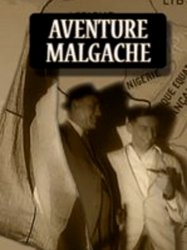
Madagascar Landing (1944)
, 30minutesDirected by Alfred Hitchcock
Origin United-kingdom
Genres Drama, War
Themes Politique, Documentary films about war, Documentary films about historical events, Political films, Documentary films about World War II
Actors Paul Bonifas
Paul Clarus, a French actor (played by "Paul Clarus") is chatting with his fellow actors (the "Molière Players") as they put on their makeup before a performance. He reminisces about a very unpleasant Vichy official, the Chef de la Sûreté, (Paul Bonifas) that he knew when he was part of the Resistance on the island of Madagascar during the Second World War. The events on Madagascar are shown in flashback.

Titanic (1943)
, 1h25Directed by Herbert Selpin, Werner Klingler
Origin German
Genres Drama, Action, Historical
Themes La fin du monde, Seafaring films, Politique, Transport films, RMS Titanic in fiction, Documentary films about war, Documentary films about historical events, Political films, Documentary films about World War II, Disaster films, Films about seafaring accidents or incidents
Actors Sybille Schmitz, Hans Nielsen, Kirsten Heiberg, Otto Wernicke, Franz Schafheitlin, Ernst Fritz Fürbringer
The film opens with a proclamation to the White Star stockholders that the value of their stocks is falling. The president of White Star Line J. Bruce Ismay promises to reveal a secret during the maiden voyage of the Titanic that will change the fate of the stocks. He alone knows that the ship can break the world record in speed and believes this will raise the stock value. Ismay and the board of the White Star plan to lower the stocks by selling even their own stocks in order to buy them back at a lower price. They plan to buy them back just before the news about the record speed of the ship will be published to the press.
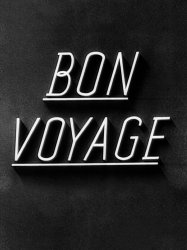
Bon Voyage (1944)
, 26minutesDirected by Alfred Hitchcock
Origin United-kingdom
Genres Drama, War, Thriller
Themes Politique, Transport films, Aviation films, Documentary films about war, Documentary films about historical events, Political films, Documentary films about World War II, Disaster films, Films about aviation accidents or incidents, Histoire de France, L'Occupation allemande en France
The story is told in flashback, once from the perspective of the protagonist, and then a second time with a deeper understanding that is provided by the intelligence officer in London.

The Most Beautiful (1944)
, 1h25Directed by Akira Kurosawa
Origin Japon
Genres Drama, War
Themes Politique, Films about the labor movement, Documentary films about war, Documentary films about historical events, Political films, Documentary films about World War II
Actors Yōko Yaguchi, Takashi Shimura, Ichirō Sugai (菅井一郎), Takako Irie, Michiko Oikawa, Akitake Kōno
The film depicts the struggle for the workers at a lens factory to meet production targets during World War II. They continually drive themselves, both singly and as a group, to exceed the targets set for them by the factory directors.
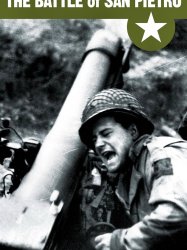
The Battle of San Pietro (1945)
, 31minutesDirected by John Huston
Origin USA
Genres War, Documentary
Themes Documentary films about war, Documentary films about historical events, Political films, Documentary films about World War II
Actors John Huston
Chronique de la bataille livrée dans San Pietro et réflexion sur les horreurs de la guerre et le prix de la liberté reconquise.
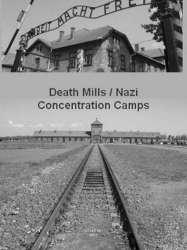
Death Mills (1945)
, 22minutesDirected by Billy Wilder
Origin USA
Genres War, Documentary
Themes Films about racism, Films about religion, Documentary films about racism, Documentary films about law, Documentary films about war, Documentary films about historical events, Documentaire sur une personnalité, Documentary films about religion, Political films, Films about Jews and Judaism, Documentary films about World War II
The film opens with a note that the following is "a reminder that behind the curtain of Nazi pageants and parades was millions of men, women and children who were tortured to death - the greatest mass murder in human history," then fades into German civilians at Gardelegen carrying crosses to the local concentration camp.
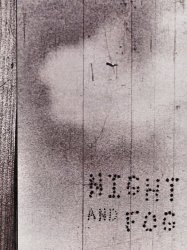
Night and Fog (1959)
, 32minutesDirected by Alain Resnais
Origin France
Genres War, Documentary, Historical
Themes Films about racism, Films about religion, Documentary films about racism, Documentary films about law, Documentary films about war, Documentary films about historical events, Documentaire sur une personnalité, Documentary films about religion, Political films, Films about Jews and Judaism, Documentary films about World War II
Actors Michel Bouquet
Night and Fog is a documentary that alternates between past and present and features both black-and-white and color footage. The first part of Night and Fog shows remnants of Auschwitz while the narrator Michel Bouquet describes the rise of Nazi ideology. The film continues with comparisons of the life of the Schutzstaffel to the starving prisoners in the camps. Bouquet then addresses the sadism inflicted upon the doomed inmates, including torture, scientific and medical "experiments", executions, and prostitution. The next section is shown completely in black-and-white, and depicts images of gas chambers and piles of bodies. The final topic of the film depicts the liberation of the country, the discovery of the horror of the camps, and the questioning of who was responsible for them.
 Connection
Connection